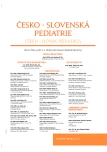The role and composition of human milk oligosaccharides
Authors:
P. Uhrík 1; Z. Uhríková 2; M. Zibolen 2
Authors‘ workplace:
Interná klinika gastroenterologická JLF UK a UN Martin, Slovensko
1; Neonatologická klinika JLF UK a UN Martin, Slovensko
2
Published in:
Čes-slov Pediat 2020; 75 (3): 183-186.
Category:
Review
Overview
The importance of breast milk oligosaccharides (HMOs) in nutrition has been overlooked for a long time. Technical advances with possibility of HMOs synthesis draw attention to this component of breast milk, as evidenced by the exceptional number of indexed publications in the PubMed database over the past 10 years. The oligosaccharide fraction is the third largest constituent of breast milk. Interindividual variability of HMO is genetically and environmentally affected. It is currently unclear whether the composition of the HMO is tailored to the specific infant needs. HMOs are similar in composition to glycocalyx of intestinal epithelial cells, affect intestinal microbiota, mucosal immunity, inhibit pathogens, thereby contributing to protection against infections. Synthetically awaited HMO 2-fucoslyllactose and lacto-N-neo-tetraose are considered safe and added to milk formula.
The review article deals with the structure of oligosaccharides of breast milk with regard to their function and benefits.
Keywords:
oligosaccharides – breast milk – intestinal microbiota
Sources
1. Bode L. Human Milk Ologosaccharides: Next generation functions and questions. In: Donovan D, et al. Human Milk Composition, Clinical Benefits and Future Opportunities. Basel: Karger, 2019 : 191–201.
2. Morrow L, Newburg D. Human milk oligosaccharide. In: Polin RA, et al. Gastroenterology and Nutrition: Neonatology Questions and Controversie. London: Elsevier, 2018 : 43–56.
3. Burianová I, Malý J, Navratilova M, et al. Změny obsahu bílkoviny v mateřském mléce po předčasném porodu. Čes-slov Pediat 2017; 72 (8): 472–478.
4. Sprenger N, Binia A, Austin S. Human milk oligosaccharides: Factors affecting their composition and their physiological significance. In: Donovan D, et al. Human Milk Composition, Clinical Benefits and Future Opportunities. Basel: Karger, 2019 : 45–56.
5. Mcguire MK, Meehan CL, Mcguire MA, et al. What’s normal? Oligosaccharide concentrations and profiles in milk produced by healthy women vary geographically. Am J Clin Nutr 2017; 105 (5): 1086–100.
6. Musilová Š, Rada V. Vliv oligosacharidů mateřského mléka na střevní mikrobiotu kojenců. Pediatr praxi 2015; 16 (1):17–19.
7. Krejsek J, Andrýs C, Krčmová I. Imunologie člověka. 1.vyd. Hradec Králové: Garamon, 2016 : 231–370.
8. Yu Z, Chen C, Newburg D. Utilization of major fucosylated and sialylated human milk oligosaccharides by isolated human milk microbes. Glycobiology 2013; 23 (11): 1281–1292.
9. Lin A, Austran C, Szyszka A, et al. Human milk oligosaccharides inhibit growth of group B Streptococcus. J Biol Chem 2017; 292 : 11243–11249.
10. Bienenstock J, Buck R, Linke H, et al. Fucosylated but not sialylated milk oligosaccharides diminish colon motor contractions. PLoS One 2013; 8 (10): 76236.
11. Neu J, Walker W. Necrotizing enterocolitis. N Engl J Med 2011; 364 (3): 255 – 264.
12. Pammi, M, et al. Intestinal dysbiosis in preterm infants preceding necrotizing enterocolitis: a systematic review and meta-analysis. Microbiom 2017; 5 : 31.
13. Puccio G, Alliet P, Cajozzo C, et al. Effects of infant formula with human milk oligosaccharides on growth and morbidity: a randomized multicenter trial. J Pediatr Gastroenterol Nutr 2017; 64 (4): 624–631.
Labels
Neonatology Paediatrics General practitioner for children and adolescentsArticle was published in
Czech-Slovak Pediatrics

2020 Issue 3
Most read in this issue
- Genital bleeding in childhood view by pediatric gynecologist
- Abdominal pain at girls in childhood and adolescent age
- Female genital tract congenital anomalies – development defects of Müllerian ducts and their derivatives – ultrasound diagnosis in pediatric and adolescent gynecology
- Eisenmenger syndrome and complications in children – case report
